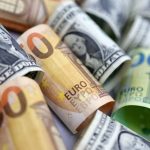
(Reuters) -The U.S. dollar was slightly lower on Tuesday, but still within striking distance of its three-month high, while the Australian dollar rose after the central bank said a rate hike may be needed to tame inflation.
The Reserve Bank of Australia (RBA) on Tuesday left rates unchanged, but cautioned about a possible further monetary tightening.
Investors have steadily pushed back bets for the first rate cut from the RBA to August, rather than June, with economists polled by Reuters also expecting the central bank to stay steady on rates well into the second half of this year.
The Aussie rose 0.35% to $0.6505, inching away from the 2-1/2 month low of $0.6469 it touched on Monday. The New Zealand dollar was 0.13% higher at $0.6063.
The repricing of the RBA monetary path “helps to provide modest support for the Australian dollar in the near-term,” said Lee Hardman, senior currency analyst, at MUFG.
“Sentiment towards the Aussie has also been boosted indirectly overnight by the rebound in the Chinese equity market where speculation is building over further state policy action to provide stability,” he added.
The Aussie dollar is usually strongly correlated to Chinese stocks, as China is Australia’s largest trading partner.
Chinese stocks recorded their biggest one-day gain since 2022 on Tuesday and the yuan rose on a slew of signals that authorities are strengthening their resolve to support slumping markets.
A string of robust U.S. economic data and remarks from Federal Reserve Chair Jerome Powell have quashed speculation of early and steep interest rate cuts and supported the dollar.
Traders have been scaling back rate cut bets since the beginning of the year and are currently pricing in only a 16% chance of a cut in March, the CME FedWatch tool showed, compared with a 69% chance at the start of the year.
They are also now pricing in around 115 basis points (bps) of cuts this year, compared with around 150 bps of easing anticipated in early January.
The dollar index, which measures the U.S. currency against six others, eased 0.11% to 104.34, having touched 104.60 on Monday, its highest since Nov. 14. The index is up 3% for the year so far, after dropping 2% in 2023.
“There seems little incentive for investors and corporates to offload any of their dollar holdings,” said Chris Turner global head of markets at ING.
“There is also the looming China Lunar New Year holiday next week, which may make the market reluctant to carry short dollar positions in an uncertain geopolitical environment,” he added.
The euro was up 0.16% at $1.0761%.
“German data are supporting the single currency,” said Roberto Mialich, forex strategist at UniCredit.
“A potential repricing of the ECB (European Central Bank) policy path towards a first rate cut in June instead of April, which we regard as likely, would prop up the euro in the medium term,” he added.
German industrial orders unexpectedly jumped in December.
Investors will focus on the ECB’s consumer expectations survey, due later in the session, which could deliver hints about the disinflation process affecting expectations for policy.
Sterling last fetched $1.2558, up 0.18% on the day, but remained close to Monday’s seven-week low.
The pound’s fall on Monday came despite some upbeat economic data. Figures showed that UK unemployment was likely much lower late last year than previously thought, which could push out British rate cuts too.
The Japanese yen was stronger on the day at 148.57 per dollar, but not far off a two-month low of 148.90 it touched on Monday.
Japan’s real wages fell for a 21st straight month, though at a slower pace, while household spending dropped for a 10th consecutive month, showing inflation outpaced wage recovery and continued to weigh on consumer spending.
To read the full article, Click Here

